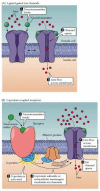Trigeminal Function in Sino-Nasal Health and Disease
- PMID: 37509418
- PMCID: PMC10376906
- DOI: 10.3390/biomedicines11071778
Trigeminal Function in Sino-Nasal Health and Disease
Abstract
The upper airway (nasal passages, paranasal sinuses, pharynx, and glottis) provides the sentinel portion of the human respiratory tract, with the combined senses of olfaction (cranial nerve I) and trigeminal sensation (cranial nerve V) signaling the quality of inspired air. Trigeminal function also complements the sense of taste (in turn mediated by cranial nerves VII, IX and X), and participates in the genesis of taste aversions. The ability of trigeminal stimulation in the upper aero-digestive tract to trigger a variety of respiratory and behavioral reflexes has long been recognized. In this context, the last three decades has seen a proliferation of observations at a molecular level regarding the mechanisms of olfaction, irritation, and gustation. Concurrently, an ever-widening network of physiological interactions between olfaction, taste, and trigeminal function has been uncovered. The objective of this review is to summarize the relatively recent expansion of research in this sub-field of sensory science, and to explore the clinical and therapeutic implications thereof.
Keywords: airflow; cough; glossopharyngeal nerve; headache; irritation; larynx; meninges; nose; paranasal sinuses; receptors; reflexes; rhinitis; sinusitis; stimulation; trigeminal nerve.
Conflict of interest statement
The author declares no conflict of interest.
Figures









Similar articles
-
Paranasal sinus nitric oxide and migraine: a new hypothesis on the sino rhinogenic theory.Med Hypotheses. 2013 Apr;80(4):329-40. doi: 10.1016/j.mehy.2012.12.001. Epub 2013 Feb 8. Med Hypotheses. 2013. PMID: 23394937
-
Occupational irritant and allergic rhinitis.Curr Allergy Asthma Rep. 2014 Apr;14(4):425. doi: 10.1007/s11882-014-0425-9. Curr Allergy Asthma Rep. 2014. PMID: 24526601 Review.
-
Sino-bronchial reflex, asthma and sinusitis.J S C Med Assoc. 1992 Jul;88(7):340-3. J S C Med Assoc. 1992. PMID: 1323731
-
Functional anatomy of the upper airway.Emerg Med Clin North Am. 1988 Nov;6(4):639-69. Emerg Med Clin North Am. 1988. PMID: 3056703 Review.
-
The Trigeminal (V) and Facial (VII) Cranial Nerves: Head and Face Sensation and Movement.Psychiatry (Edgmont). 2010 Jan;7(1):13-6. Psychiatry (Edgmont). 2010. PMID: 20386632 Free PMC article.
Cited by
-
The Exchange Breathing Method for Seizure Intervention: A Historical and Scientific Review of Epilepsy and Its Evolving Therapeutic Paradigms.J Pers Med. 2025 Aug 18;15(8):385. doi: 10.3390/jpm15080385. J Pers Med. 2025. PMID: 40863447 Free PMC article. Review.
-
Isolated Dizziness as an Atypical Presentation of Ethmoid Sinus Mucocele: A Case Report.Cureus. 2025 Jul 29;17(7):e89024. doi: 10.7759/cureus.89024. eCollection 2025 Jul. Cureus. 2025. PMID: 40895904 Free PMC article.
-
Wrist and ankle acupuncture relief moderate to severe postoperative pain after functional endoscopic sinus surgery: A randomized controlled study.Br J Pain. 2025 Apr;19(2):115-124. doi: 10.1177/20494637241264941. Epub 2024 Jun 24. Br J Pain. 2025. PMID: 40078447 Free PMC article.
-
Sensory and Autonomic Fibers in Anterior Ethmoid, Posterior Nasal, Posterolateral Nasal Nerves.Laryngoscope. 2025 Aug;135(8):2702-2712. doi: 10.1002/lary.32164. Epub 2025 Apr 7. Laryngoscope. 2025. PMID: 40192001 Free PMC article.
References
-
- Huff T., Weisbrod L.J., Daly D.T. StatPearls [Internet] StatPearls Publishing; Treasure Island, FL, USA: 2023. Neuroanatomy, Cranial Nerve 5 (Trigeminal) - PubMed
-
- Sherrington C.S. The Integrative Action of the Nervous System. Yale University Press; New Haven, CT, USA: 1906.
-
- Parker G.H. The Relations of Smell, Taste and the Common Chemical Sense in Vertebrates. Acad. of Natural Sciences; Philadelphia, PA, USA: 1912.
-
- Keele C.A., Armstrong D. Substances Producing Pain and Itch. Monographs of the Physiological Society; London, UK: 1964.
Publication types
LinkOut - more resources
Full Text Sources

